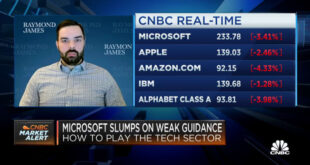Budweiser beer products manufactured by Anheuser-Busch InBev NV sit on display during a news conference in Hong Kong, China, on Thursday, July 4, 2019.
Kyle Lam | Bloomberg | Getty Images
The world’s largest brewer is making a big push for China and other parts of Asia — but it could prove challenging for Anheuser-Busch InBev to topple local beers that have long dominated their home markets.
After listing its Budweiser APAC in Hong Kong last week, AB InBev said it will be looking to expand in Asia, especially in China, South Korea, India and Vietnam.
But in China — where premium beers are popular — AB InBev is in third position with a 16% market share, according to Euromonitor. Across Southeast Asia, the company is not even in the top ten places.
“Local Chinese beer companies have very strong control on the local regional share market so it remains to be seen what Budweiser’s strategy (is) going forward from here,” Bank of Communications International’s chief strategist, Hao Hong told CNBC.
Analysts say big players have already been buying up smaller beer companies in Asia, and that could be one of the strategies for AB InBev.
However, local beers still dominate in Asia.
China’s brews
China is the world’s largest beer market by sales but firms have found it challenging amid fierce competition between local brewers and global beer giants.
China Resources Beer has more than 25% market share in the Chinese market, according to Reuters. Its vastly popular Snow beer is the top-selling beer in the world by volume.
The company is the largest local brewer by market value, followed by Tsingtao Brewery and Chongqing Brewery, Refinitiv data shows.
While the local Chinese brewers have a strong presence in the regional share market, the beer market in China is still largely fragmented, Hong said.
He added that China’s tipple of choice is still the baijiu, a traditional drink made from fermented grain that holds sway in the country.
“The segment that is really doing well is the baijiu … so it remains to be seen how much further growth the company can get from the Chinese market,” he said, referring to Budweiser APAC.
About half of all beer consumed across the globe are sold by AB InBev, Heineken, Carlsberg and China’s Snow.
In addition to Budweiser, AB InBev also owns other popular beers such as Stella Artois, Corona and Hogaarden.
Southeast Asia beer deals
Southeast Asia could prove to have better prospects, as it is projected to be a key driver for growth, according to research analyst at Euromonitor, Jarred Neubronner. Key markets would be Vietnam and Philippines, he added.
“(AB InBev) is still not among the top 10 players in the Southeast Asian region in 2018 due to the dominance of local beer players,” he said. “In order to grow further, the company needs to make a breakthrough in Southeast Asia countries such as Vietnam and Philippines.”
Some players have already done so by acquiring domestic brands in some of those markets.
Employees arrange bottles of Moutai baijiu at the Kweichow Moutai factory in the town of Maotai in Renhuai, Guizhou province, China, Dec. 14, 2017.
Qilai Shen | Bloomberg | Getty Images
Thai Beverage, for instance, bought over Vietnam’s largest beer company Sabeco (Saigon Beer Alcohol Beverage Corp) in a $4.8 billion deal in 2017. “(That) immediately catapulted Thai Beverage to become the number one beer player by volume in Southeast Asia,” said Neubronner.
Across Asia-Pacific, the company, which is listed in Singapore, ranked sixth in 2018 in terms of market share at 3.9%, according to Euromonitor.
“Many leading beer players in Southeast Asia are local players with strong local knowledge and distribution networks, so acquisitions of local beer companies is possible if AB InBev wishes to increase its market share in the region and tap on the expertise from established local players,” Neubronner said.
In China, Heineken took a 40% stake in China Resources Beer last year, in a challenge to AB InBev place in the premium lager market there.
However, beer might be losing ground to spirits, wine and other alcoholic beverages.
Beer consumption in China is set to drop almost one billion liters by 2023, as consumers switch to other alcoholic beverages such as spirits, according to Euromonitor.
Cheers to alcohol stocks
Demand for alcohol-related stocks in Asia has been strong, according to KraneShares Chief Investment Officer Brendan Ahern, whose firm operates 16 China-focused ETFs with $2.5 billion assets under management.
Commenting on the Budweiser IPO, he said: “Alcohol stocks have been a favored sector for Asia investors of late, which the company is tapping into.”
Under the KraneShares Bosera MSCI China A ETF, the distillers and vintners sub-sector stocks are up 101%, while brewers are up 33% year to date, according to Ahern.
“Revenues and (earnings per share) growth for the underlying companies have been very strong as demand from Chinese consumers continues to grow,” he said. “The companies have been able to expand production while maintaining pricing due to the strong demand.”
Ahern flagged ultra-premium Chinese baijiu distiller Kweichow Moutai — considered a bellwether among China’s consumer stocks, and said the company’s revenues and earnings per share have doubled between 2015 and 2018.
— CNBC’s Yen Nee Lee and Reuters contributed to this report.
 EU News Digest Latest News & Updates
EU News Digest Latest News & Updates



